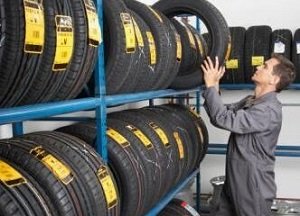Recent Posts
Categories
Do Your Homework on Tire Safety
August 13th, 2015
We see it all the time…people tend to not think about their tires until something goes wrong. Sometimes, this can mean sitting on the side of the road waiting for help, and other times it can mean more serious consequences. Here are a few things to remember for tire safety as the summer winds down and back-to-school season starts.

• Check your tire pressure regularly. This one is really important. Your car’s tires will lose air through the valve over time, and an underinflated tire will hurt fuel economy due to added rolling resistance. Low tires also affect handling and will generate enough heat that they can shorten the tire’s lifespan. Get a quality tire gauge (the dial type, not the pencil type) and check the inflation of all four tires once a month. Make sure to check inflation while the tires are cold, and inflate them to the manufacturer’s specifications. Tire inflation levels can be found on a sticker, either under the hood, on the driver’s door jamb or inside the fuel filler lid.
• Don’t mix tires. If you have a tire which fails altogether and can afford to only replace that tire, make sure it’s the same size and tread pattern as the rest, and preferably the same brand. It’s best to replace all four tires at once, or at least in pairs. Mixing sizes and designs of tires can result in a vehicle that’s never going to drive, handle or ride correctly.
• Rotate your tires regularly. No vehicle has even weight distribution from front to rear, and front tires will always be subject to more wear due to cornering and braking forces. Switching the positions of the tires regularly ensures even wear and long tire life. Tires should be rotated at 5,000 mile intervals; since oil changes should also fall at around the same interval, it’s easy enough to just schedule them both for the same appointment.
• Inspect your tires’ tread depth. 2/32” is considered the minimum safe tread depth in most states. Here’s an easy way to check that: take a penny and insert it into the tread grooves, Lincoln’s head down. If you can see any portion of the top of Lincoln’s head, you’re below minimum tread depth. Now, try the same test with a quarter. Can you see the top of Washington’s head? You’re below 4/32” tread depth. Insert the penny into the tread again – if the rubber reaches the Lincoln Memorial, your tread depth is under 6/32”.
• Inspect the tires’ condition. Look closely for damage or foreign objects. Examine the tires closely for uneven wear and run your hand along the tread surface to feel for irregularities; any of these could indicate alignment or suspension problems.
Don’t let tires be one more thing for you to worry about as you shuttle the kids back and forth to school. Got any questions, or feel like maybe it’s time to just break down and buy another set of tires? Make an appointment with us and let us help you out.
Tags:
new tires, truck tires, car tires, tire repair, buy tires, tires, safe tires, tire replacement
Posted in:
Tire 101
